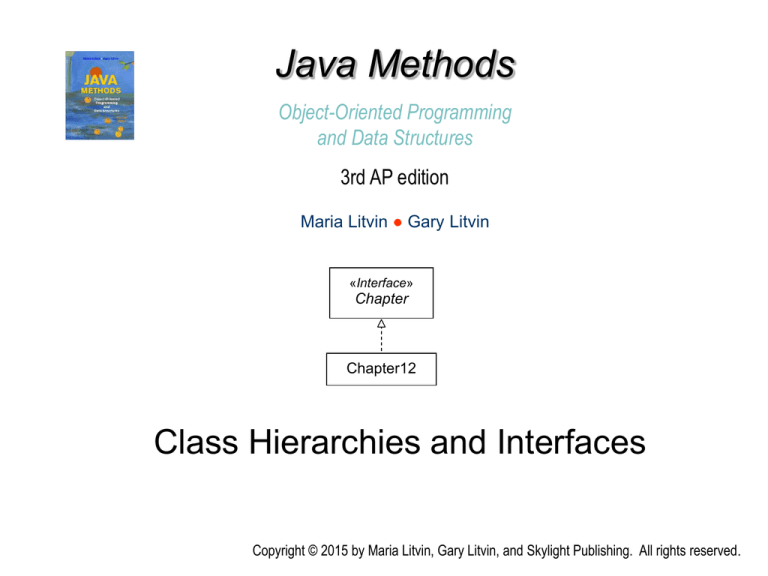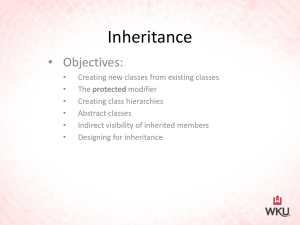
Java Methods
Object-Oriented Programming
and Data Structures
3rd AP edition
Maria Litvin ● Gary Litvin
«Interface»
Chapter
Chapter12
Class Hierarchies and Interfaces
Copyright © 2015 by Maria Litvin, Gary Litvin, and Skylight Publishing. All rights reserved.
Objectives:
• Understand class hierarchies and
polymorphism
• Learn about abstract classes
• Learn the syntax for calling superclass’s
constructors and methods
• Understand interfaces
12-2
Inheritance
Superclass
(Base class)
Subclass extends
Superclass
Subclass
(Derived class)
• Inheritance represents the IS-A relationship
between objects: an object of a subclass
IS-A(n) object of the superclass.
12-3
Class Hierarchies
• Using inheritance, a programmer can define a
hierarchy of classes.
Balloon
RoundBalloon
BirthdayBalloon
SquareBalloon
FancyBalloon
HotAirBalloon
12-4
Class Hierarchies (cont’d)
• Help reduce duplication
of code by factoring out
common code from
similar classes into a
common superclass.
RoundBalloon
Constructor
draw (redefined)
Balloon
Constructors
Accessors
distance
move
setRadius
isInside
isOnBorder
draw
OvalBalloon
Constructor
distance (redefined)
draw (redefined)
12-5
Class Hierarchies (cont’d)
• Help reduce duplication of code by letting you
write more general methods in client classes.
public void add (RoundBalloon b)
{
balloons.add(b);
}
public void add (OvalBalloon b)
{
balloons.add(b);
}
Works for a any kind
of Balloon
public void add (Balloon b)
{
balloons.add(b);
}
12-6
Abstract Classes
• Some of the methods in a class can be
declared abstract and left with only signatures
defined
• A class with one or more abstract methods
must be declared abstract
Abstract
method
public abstract class Balloon
{
...
public abstract void draw (Graphics g, boolean makeItFilled);
}
12-7
Abstract Classes (cont’d)
• Abstract classes serve as common
superclasses for more specific classes
• An abstract method provides an opportunity
for the compiler to do additional error
checking
• Abstract classes are closer to the root of the
hierarchy; they describe more abstract
objects
12-8
Abstract Classes (cont’d)
Object
...
Component
...
Button
TextComponent
...
...
...
JTextComponent
Container
JComponent
AbstractButton
JTextArea JTextField ... JMenuItem
Window
JPanel
JButton
...
...
A fragment of Java library GUI class hierarchy
(abstract classes are boxed)
12-9
Abstract Classes (cont’d)
• Java does not allow us to instantiate (that is,
create objects of) abstract classes
• Still, an abstract class can have constructors
they can be called from constructors of
subclasses
• A class with no abstract methods is called
concrete
12-10
Class Object
• In Java every class by default extends a
library class Object (from java.lang)
• Object is a concrete class
public class Object
{
public String toString {...}
public boolean equals (Object other) {... }
public int hashCode() { ... }
Methods
redefined
(overridden)
as necessary
// a few other methods
...
}
12-11
Invoking Superclass’s
Constructors
RoundBalloon
BirthdayBalloon
public class BirthdayBalloon extends RoundBalloon
{
// Constructor
public BirthdayBalloon (int x, int y, int r, Color c, int age)
{
Calls RoundBalloon’s
super(x, y, r, c);
constructor
this.age = age;
}
}
The number / types of parameters passed to
If present, must be
the first statement
super must match parameters of one of the
superclass’s constructors.
12-12
Invoking Superclass’s
Constructors (cont’d)
• One of the superclass’s constructors is
always called, but you don’t have to have an
explicit super statement.
• If there is no explicit call to super, then
superclass’s no-args constructor is called by
default.
Must be defined then. If not defined syntax error:
cannot find symbol : constructor ...
12-13
Invoking Superclass’s
Constructors (cont’d)
• Superclass’s constructor calls its superclass’s
constructor, and so on, all the way up to
Object’s constructor.
Object
super( )
super( )
super( )
Balloon
RoundBalloon
BirthdayBalloon
12-14
Calling Superclass’s
Methods
RoundBalloon
BirthdayBalloon
public class BirthdayBalloon extends RoundBalloon
{
...
public void draw (Graphics g, boolean makeItFilled)
{
g.setFont (ageFont);
Calls RoundBalloon’s draw
super.draw (g, makeItFilled);
g.setColor (Color.BLACK);
g.drawString("" + age, getX() - 10, getY());
}
}
super.someMethod refers to someMethod in the
nearest class, up the inheritance line, where
someMethod is defined.
12-15
Calling Superclass’s
Methods (cont’d)
• super-dot calls are often used in
subclasses of library classes:
public class Canvas extends JPanel
{
...
public void paintComponent (Graphics g)
{
super.paintComponent (g);
...
}
...
12-16
Polymorphism
• Ensures that the correct method is called for
an object of a specific type, even when that
object is disguised as a reference to a more
generic type, that is, the type of the object’s
superclass or some ancestor higher up the
inheritance line.
• Once you define a common superclass,
polymorphism is just there no need to do
anything special.
12-17
Polymorphism (cont’d)
public void paintComponent (Graphics g)
{
super.paintComponent(g);
for (Balloon b : balloons)
{
b.draw (g, true);
}
}
The correct draw method is
called automatically for any
specific type of balloon
12-18
Interfaces
Chess
ComputerPlayer
Checkers
Player
HumanPlayer
Chomp
Interface
12-19
Interfaces (cont’d)
• An interface in Java is like an abstract class,
but it does not have any fields or constructors,
and all its methods are abstract.
public interface Strategy
{
Location findBestMove (ChompGame game);
Location findRandomMove (ChompGame game);
}
• “public abstract” is not written because all the
methods are public abstract.
12-20
Interfaces (cont’d)
• We must “officially” state that a class
implements an interface.
• A concrete class that implements an interface
must supply all the methods of that interface.
public class Waltz implements Dance
{
...
public String getName( ) { return "Waltz"; }
public String getSteps (int m) { ... }
public int[ ] getBeat ( ) { ... }
...
}
12-21
Interfaces (cont’d)
• A class can implement several interfaces.
• Like an abstract class, an interface supplies a
secondary data type to objects of a class that
implements that interface.
• You can declare variables and parameters of
an interface type.
Dance d = new Waltz( );
• Polymorphism fully applies to objects
disguised as interface types.
12-22
Interfaces (cont’d)
public interface Edible
{
String getFoodGroup();
int getCaloriesPerServing();
}
public class Pancake
implements Edible
{
...
}
public class Breakfast
Polymorphism:
{
the correct
private int myTotalCalories = 0;
method is called
...
for any specific
public void eat (Edible obj, int servings)
type of Edible
{
(e.g., a Pancake)
myTotalCalories +=
obj.getCaloriesPerServing () * servings;
}
...
}
12-23
Classes
Interfaces
Similarities
• A superclass provides a
secondary data type to
objects of its
subclasses.
• An abstract class
cannot be instantiated.
• An interface provides a
secondary data type to
objects of classes that
implement that
interface.
• An interface cannot be
instantiated.
12-24
Classes
Interfaces
Similarities
• A concrete subclass of
an abstract class must
define all the inherited
abstract methods.
• A class can extend
another class. A
subclass can add
methods and override
some of its superclass’s
methods.
• A concrete class that
implements an interface
must define all the
methods specified by
the interface.
• An interface can extend
another interface (called
its superinterface) by
adding declarations of
abstract methods.
12-25
Classes
Interfaces
Differences
• A class can extend only
one class.
• A class can have fields.
• A class can implement
any number of
interfaces.
• An interface cannot
have fields (except,
possibly, some public
static final constants).
• A class defines its own
constructors (or gets a
default constructor).
• An interface has no
constructors.
12-26
Classes
Interfaces
Differences
• A concrete class has all
its methods defined. An
abstract class usually
has one or more
abstract methods.
• Every class is a part of
a hierarchy of classes
with Object at the top.
• All methods declared in
an interface are
abstract.
• An interface may
belong to a small
hierarchy of interfaces,
but this is not very
common.
12-27
Review
• Describe two ways for eliminating duplicate
code using class hierarchies.
• What is an abstract class?
• Why is it better to use an abstract method
rather than an empty method?
• Define concrete class.
• What happens when a constructor of a
subclass does not have a super statement?
Is superclass’s constructor called?
12-28
Review (cont’d)
• Can an abstract class be instantiated?
• Can someMethod1 have a call
super.someMethod2 ( )?
• What happens if, by mistake, a programmer
puts in his paintComponent method a call
paintComponent(g);
instead of
super.paintComponent(g);
?
12-29
Review (cont’d)
• What is the main difference between an
abstract class and an interface?
• Can a class implement several interfaces?
• Suppose you declare a variable of an
interface type. What type of value can be
assigned to that variable?
• What is the main advantage of interfaces over
abstract classes?
12-30





